The Wells Brothers' Battleship Index: Debunking the Later H-class Battleships
25 July 2021
Introduction
The H-class was a series of never-completed German battleships from the World War II era.
Two (of a planned six) were begun to the original H-39 design, but their construction
was quickly abandoned after the start of the war. While some design work continued, no
further actual construction was done.
We are continually surprised at the amount of misinformation on the web about the German H-class designs,
especially the later evolutions, and so we have written this page to present the better information. We
make no pretense that our page is the result of original research. It is, rather, a clear presentation of
the "conventional wisdom" about these never-completed battleships. In this case, the "conventional
wisdom" is clearly correct, and is quite well documented.
Most of our information comes from five sources:
- Dulin & Garzke "Battleships: Axis and Neutral Battleships of World War Two"
- Breyer, Sigfried: "Battleships and Battleruisers 1905-1970"
- Gröner , Erich et al. "German Warships 1815-1945"
- Anonymous, Marine Rundschau 1956
- Campbell, John: "Naval Weapons of World War Two"
Interestingly enough, Breyer is probably the most useful. While his book is a bit old, and significant research has been done since it was published, it still covers the H-class and the later design studies remarkably well.
The imaginary ships at the end of this page are obviously not documented in offical or otherwise reliable sources.
We have had to rely in many cases on old data collected from defunct websites, and personal memory.
The Earlier Designs H-39 through H-41
The earlier H-class designs were mostly practical and realistic. H-39 was certainly buildable, and would have been a reasonably good battleship for its day, though many think the armor protection inadequate. The H-39 design was derived from the earlier Bismarck-class, though there were some significant differences.
The most obvious difference is the main guns. The Bismarck-class had 38cm guns, whereas the H-class had 40.6 cm/52 SK C/34 guns, or in the case of H-41, the closely related 42 cm/48 SK C/40 gun.
Another major difference was propulsion. The H-39 and H-41 designs were to be powered by diesel engines instead of steam turbines, but still on three shafts, as in previous classes. The two H-40 designs, which seem to be something of a tangent from the series, would have had a combination of diesel and steam turbine engines.
The hangar and aircraft arrangements were also quite different from the Bismarck-class. The air intakes, mufflers, and exhausts of the diesel engines, combined with the need for a second funnel and boat storage, precluded the use of a transverse catapult amidships. The H-class would have had a large hangar forward of Turret "Caesar", and a catapult mounted below the guns of the aft-most turret. The catapult position seems particularly impractical, as the aft-most turret would have to either raise its guns or rotate the turret in order to launch aircraft.
The secondary and dual purpose armament remained the same through all versions: Twelve 150mm/55 SK C/28 guns in six twin mounts, plus sixteen 105mm/65 SK C/33 guns in eight twin mounts. Note that the 105mm/65 SK C/33 mounts were the newer, heavier enclosed Dop. L. C/38 mounts, rather than the open C/31 and C/37 mounts used on the preceeding Bismarck-class.
Overall, the armor protection was probably inadequate for a ship of this size and power. The earlier H-class designs called for a thinner belt armor than the preceeding Bismarck-class.
(30 cm vs 32 cm), though apparently a bit taller. Apparently, the German designers believed that the armor belt plus the sloped armor behind it would give the ships' vital spaces the
equivalent of a 50 cm belt.
The experience of the Bismarck suggests that this was probably not so. Further, the horizontal armor was not as thick as that on some
of the H-class' contemporaries. On the other hand, they would have had relatively good torpedo protection and good subcompartmentation.
All of the H-class designs called for six underwater 533mm (21 inch) torpedo tubes built into the forward part of the hull.
| Design
| Length in meters
| Beam in meters
| Draft in meters
| Standard Displacement in metric tons
| Design Displacement in metric tons
| Full Load Displacement in metric tons
| Main Armament
| Propulsion
|
| H-39
| 266 (wl), 277.75 (oa)
| 37
| 10.024 (standard) 11.2 (full load)
| 53,489
| 58,543
| 63,596
| eight 16"/L52 (406mm) SK C/34 guns in four twin turrets
| Twelve MAN MZ65/95 diesels, three shafts, 165,000 MHP
|
| H-40A
| 270 (wl)
| 37.6
| 10.02
| 55,700
| 58,500
| 65,600
| six 16"/L52 (406mm) SK C/34 guns in three twin turrets
| Eight MAN MZ65/95 diesels on outer shafts, steam turbine on center shaft, three shafts, 230,000 MHP , 30.4 knots
|
| H-40B
| 287 (wl)
| 39.2
| 10.02
| 63,000
| 66,000
| 70,000
| eight 16"/L52 (406mm) SK C/34 guns in four twin turrets
| MAN VZ42/58 diesels on outer shafts, steam turbine on center shaft, three shafts, 240,000 MHP 30.4 knots
|
| H-41
| 275 (wl)
| 39
| 11.1 (design) 12.15 (full load)
| 64,000
| 68,800
| 76,000
| eight 16.54"/L48 (420mm) SK C/40 guns in four twin turrets
| Twelve MAN MZ65/95 diesels, three shafts, 165,000 MHP 28.8 knots
|
- H-39

Sigfried Breyer's drawing of the H-39 design, from his classic volume "Battleships and Battlecruisers 1905-1970"
H-39 was a real design. Indeed, two ships were begun to this design. They would have been large, diesel powered battleships with eight 16-inch guns. Six ships were planned.No names were assigned. Usually in this era, German warships were not officially named until they were launched. As noted above, neither the belt armor nor the deck armor were up to the standards of the day, but the hulls were well subdivided, and had good torpedo protection. The diesel engines would have provided good cruising range, over 16,000 miles at 19 knots.
| Ship | Shipyard | Keel Laid | Disposition
|
| H | Blohm & Voss, Hamburg | 15 July 1939 | Construction halted 30 September 1939. Dismantled 25 November 1941, contract cancelled 29 August 1942
|
| J | Deschimag, Bremen | 1 September 1939 | Construction halted 30 September 1939. Dismantled 25 November 1941, contract cancelled 29 August 1942
|
| K | Deutsche Werke, Kiel | Cancelled
|
| L | Kriegsmarine Werft, Wilhelmshaven | Cancelled
|
| M | Blohm & Voss, Hamburg | Cancelled
|
| N | Deschimag, Bremen | Cancelled
|
- H-40
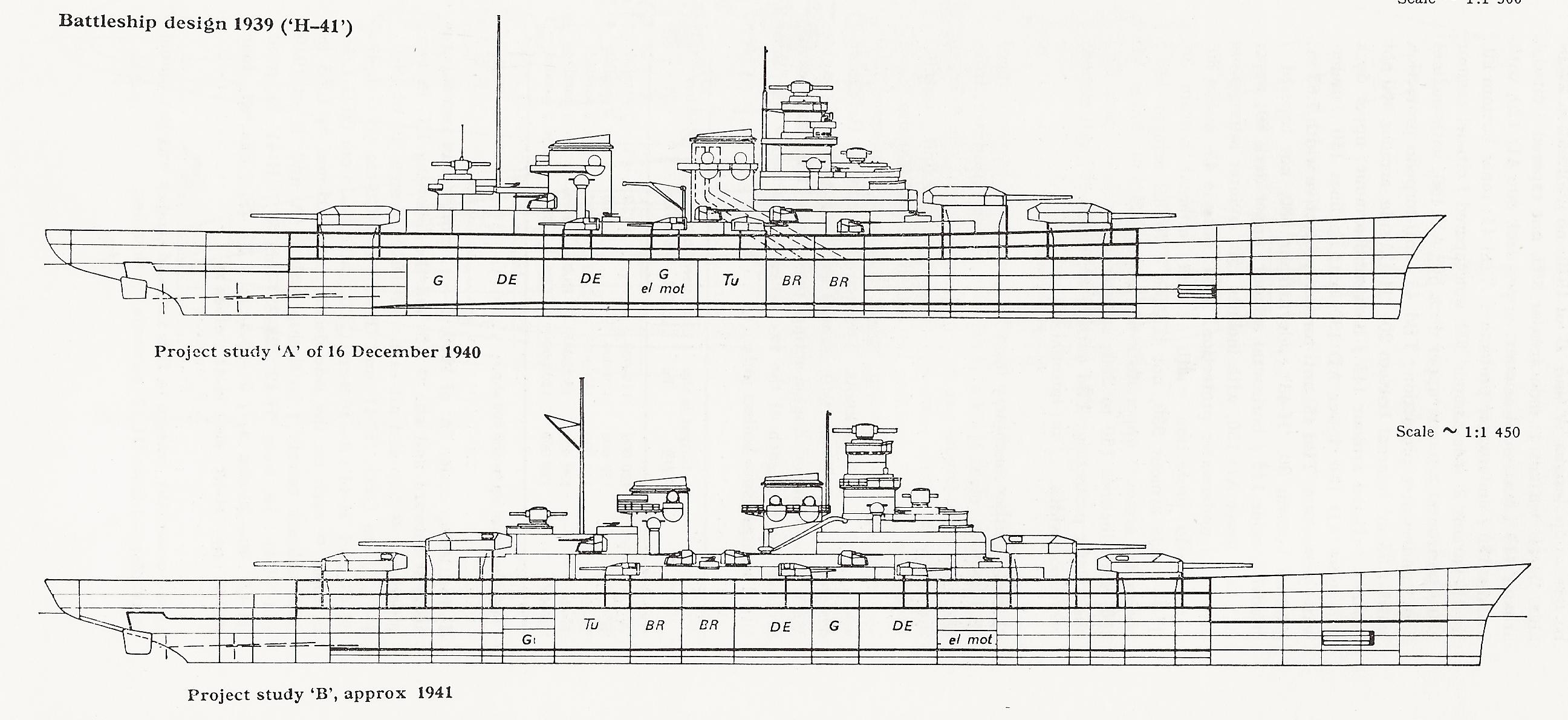
Breyer's drawing of the two 1940 designs.
The two H-40 designs aren't documented at all in Gröner. Breyer does not call these designs H-40. He describes them, but doesn't give them their own subheading. They
are best documented in Dulin & Garzke's "Battleships: Axis and Neutral Battleships in World War II". To the best of my knowledge, they are the only ones who called these
two designs "H-40" Many sources just call them "A" and "B".
The two H-40 designs had a substantially different propulsion system from H-39 and H-41. Both designs had combined diesel and steam propulsion on four shafts instead of three.
H-40A H-40A was an attempt to put improved armor on a hull similar in size to H-39. Something had to give, though, and in this case, it was one of the aft turrets. This six-gun design invites comparisons to the never-built O-class battlecruisers. Obviously, H-40A was a bigger ship with bigger guns and substantially better armor. Like the O-class, H-40A would have had a combined diesel and steam propulsion system, with diesels driving the outer shafts, and steam turbines driving the inner shafts. (the O-class had only three shafts)
I have found an interesting bit of misinformation based on H-40A. Back in 2013, a poster identified by the screen name "Banelord300" posted a profile drawing
of H-40A on this World of Warships forum page.
He claims the ship has nine guns in its three turrets. The drawing looks like a copy of
Michael Emmerich's drawing.
In reality, H-40A would have had twin turrets, so the total of six guns is correct.
H-40B H-40B attempted to have the improved armor of H-40A, while retaining all four main turrets. The result was a much larger battleship.
- H-41
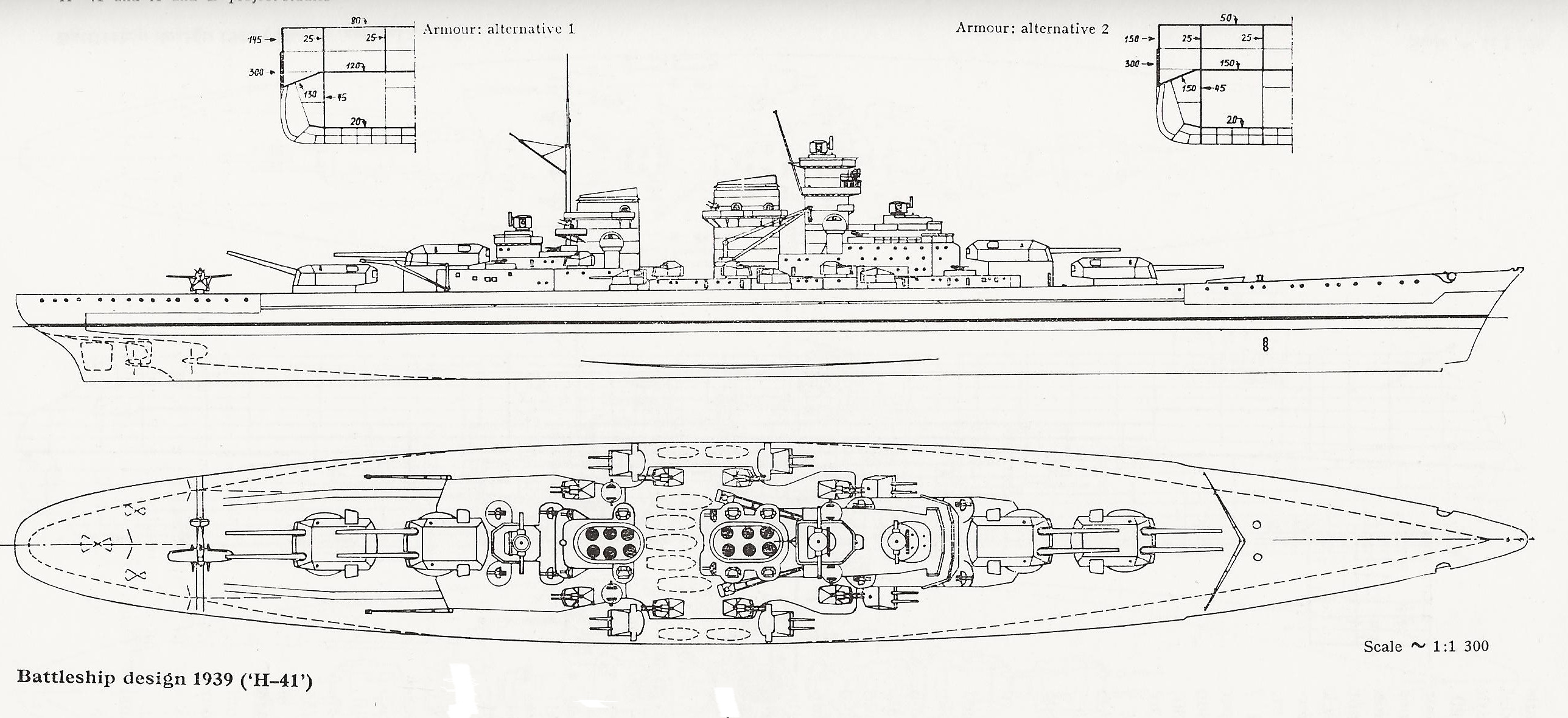
Breyer's drawing of H-41.
H-41 was the last of the "real" designs. It was very much a redesign of H-39, and was not closely related to either of the H-40 designs. According to D&G, after the Scharnhorst was bombed in July 1941, the Germans realized that if the H-class were to be completed, they would need thicker deck armor. That required the ship to be bigger. H-41's large size would have caused problems. The Deschimag shipyard could not have built an H-41 battleship because of shallow waters near Bremen.
Further, D&G suggest that the 12.15 m full load draft would be too deep for any North Sea port (11.5 meters was apparently the maximum) and they would need to assume
that a deep Atlantic port would be available to them. These ships could have sailed at "design" displacement (40% fuel) at a draft of 11.1 meters.
H-41 was also the first to feature the 42 cm/L48 SK C/40 main gun. (Note: Tony DiGiulian of navweaps.com claims that the SK /C40 designation is his own. We have not seen it anywhere else, so we do not doubt him) In reality, this gun was more or less a 16"/L52 SK C/34 that with a thinner liner. Apparently, Krupp designed the 16" /L52 SK C/34 with an extra thick liner so that it could be changed to 42 cm bore without any major modifications.
All other guns would have been the same as on H-39.
Propulsion would also have been identical to that on H-39. Since H-41 would have been a larger ship, maximum speed would have been reduced to 28.8 knots.
There was one final redesign. On 15 November 1941, Admiral Raeder approved a full load displacement increase to 79,000 metric tons, with a waterline length of 282 meters, a beam of 40.5 meters, and a full load draft of 12 meters. The deck armor would have been changed (150mm on the armor deck alone) but speed would have fallen to 28 knots.
The Later Designs H-42 through H-44
The later designs were little more than studies. Indeed, they were not designed by the Kriegsmarine's own Warship Construction Office (Konstruktions Amt, or K-Amt), but rather by a New Ship Construction Committee (schiffsneubaukommission). This latter organization, headed by Admiral Karl Topp, was supposed to coordinate requirements and materials with Reichsminister for Armament and Munitions Albert Speer. The designs were primarily intended to figure out how big a ship would have to be to support the armor needed to protect against increasingly large bombs.
These designs also investigated increasingly large torpedo protection schemes. There was no intention of actually building these ships, and each successive design became less practical. They were never even discussed with the Naval High Command.
As with the earlier H-class battleships, the secondary and dual purpose armament remained the same through all versions: Twelve 150mm guns in six twin mounts, plus sixteen 105mm guns in eight twin mounts.
Another feature common to these three later designs is the propulsion system. All would have had 270,000 mhp on four shafts, with MAN MZ 65/95 diesels on the outer shafts, and steam turbines on the inboard shafts.
Armor thicknesses were also remarkably similar. All three featured 33 cm (13") of deck armor and 38cm (15") of belt armor. The deck armor would have been on three decks, 6 cm plus 14 cm plus 13 cm. Most accounts suggest that H-43 and H-44 would have had "deeper" armor belts than H-42.
Also of some interest, these designs shared a "tunnel" stern.
Breyer writes: "From this 'H-42' design onwards, efforts were made to give rudders and propellers maximum protection by extending the stern of
the ship in the shape of two side fins forming a kind of tunnel and protecting the rudder and propellers from the sides. This design was to offer protection against the kind of fateful torpedo hits sustaned by Bismarck. The effect such a stern would have on manoeuvrability of so large a ship was not looked into and extensive model tests would have been necessary before such a project could have been carried out."
While Breyer refers to his drawings, to our eyes, the design is not clear.
The wording suggests a similarity to the "Twin Skeg" arrangement on the final generation of American battleships,
but we cannot confirm this from Breyer's drawings.
It would have been very difficult for the Germans to launch ships of such immense size in the traditional manner. Apparently, to the extent that there was any intent of building them at all after the war, they intended to build them in drydocks. Modern American supercarriers are built this way. Apparently, the Germans did begin to build such drydocks in World War II.
Aircraft arrangements were very similar to those on the earlier H-class
There is some dispute about the main armament on some of these designs. Dulin & Garzke
and Breyer
agree that H-42 was designed with 42 cm guns, and H-43 and H-44 were designed with 50.8 cm (20") guns. Groener discusses a 48 cm (18.8") gun for H-42 and H-43.
Apparently, the 50.8 cm gun was not related to Krupp's 53 cm Gerät 36 gun. From what little we have found on this putative 50.8 cm gun, it was only used for a size estimate. Neither the gun nor the turret were ever designed in detail.
Aside from the main armament, the main difference in these ships seems to be the depth of the torpedo protection. The length of the ship had to increase proportionally to the ever increasing beam.
| Design
| Length in meters
| Beam in meters
| Draft in meters
| Standard Displacement in metric tons
| Design Displacement in metric tons
| Full Load Displacement in metric tons
| Main Armament
| Propulsion:
|
| H-42
| 305 (wl)
| 42.8
| 19.15
| 83,265
| 90,000
| 98,000
| eight 16.54"/L48 (420mm) SK C/40 guns in four twin turrets
| Eight MAN MZ65/95 diesels on outer shafts, steam turbine on center shaft, four shafts, 270,000 MHP , 31.9 knots
|
| H-43
| 330 (wl)
| 48
| 20
| 103,342
| 111,000
| 120,000
| eight 20"/L52 (508mm) 34 guns in four twin turrets
| Eight MAN MZ65/95 diesels on outer shafts, steam turbine on center shaft, four shafts, 270,000 MHP , 30.9 knots
|
| H-44
| 345 (wl)
| 51.5
| 21
| 122,000
| 131,000
| 141,500
| eight 20"/L52 (508mm) 34 guns in four twin turrets
| Eight MAN MZ65/95 diesels on outer shafts, steam turbine on center shaft, four shafts, 270,000 MHP , 29.8 knots
|
Note: While "standard" displacement was rigidly defined by the Washington Treaty of 1921-22, "design" displacement was a unique German measurement. Standard displacement included everything except fuel and reserve feed water. Design displacement added the weight of a 40% load of fuel.
- H-42

Breyer's drawing of H-42.
This was the first of the design studies. While Gröner says that the main guns were 48 cm, both Breyer and Dulin & Garzke say that they were 42mm. H-42 established the pattern for deck and belt armor on these later studies. The torpedo protection was 7.87 meters wide on each side.
- H-43
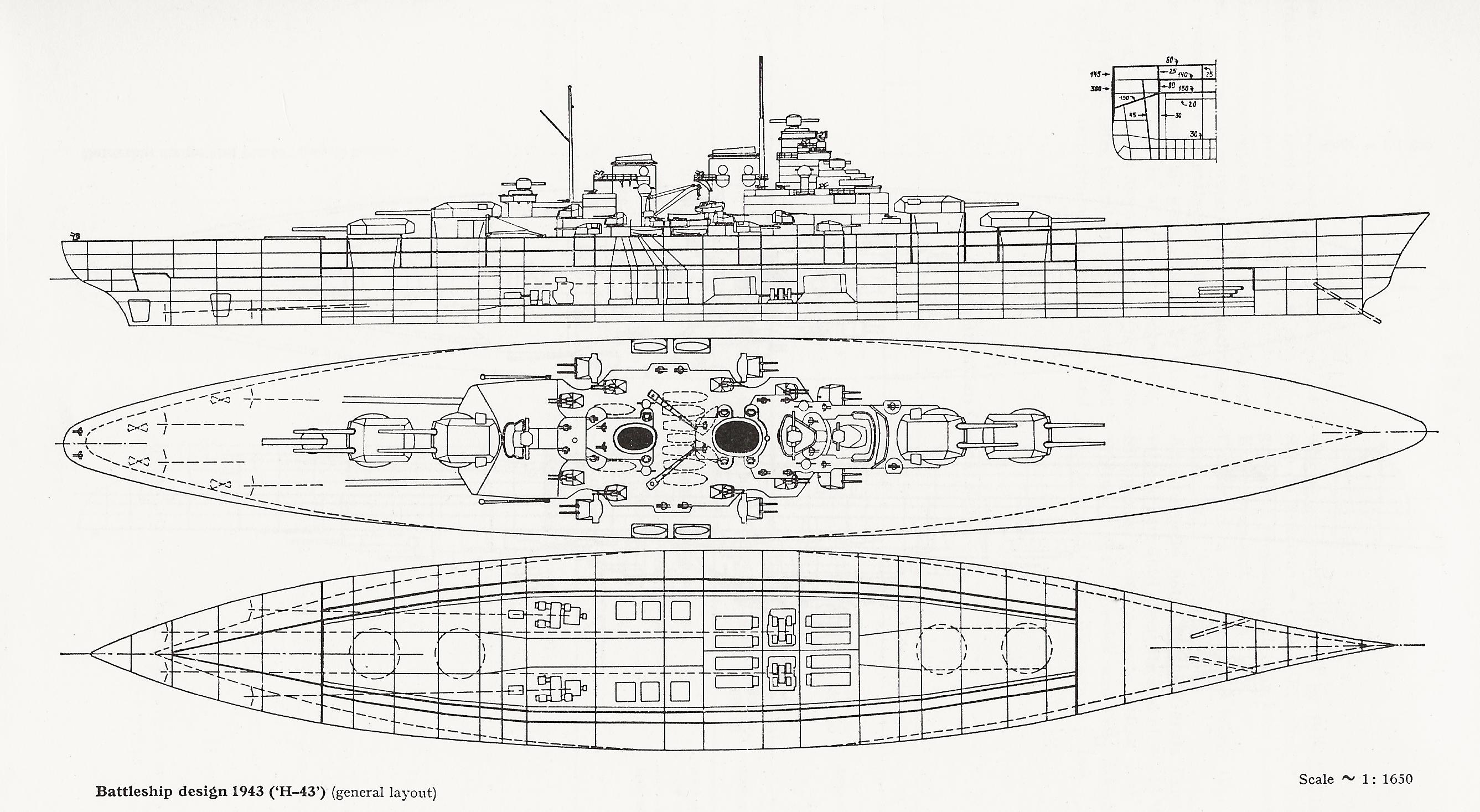
Breyer's drawing of H-43. Note the problem with the dotted waterline in the "plan" view. It doesn't meet the stem!
Despite what Gröner tells us, we still think that the H-43 design called for the 50.8 cm (20 inch) gun. The torpedo protection was 9.5 meters on each side.
- H-44
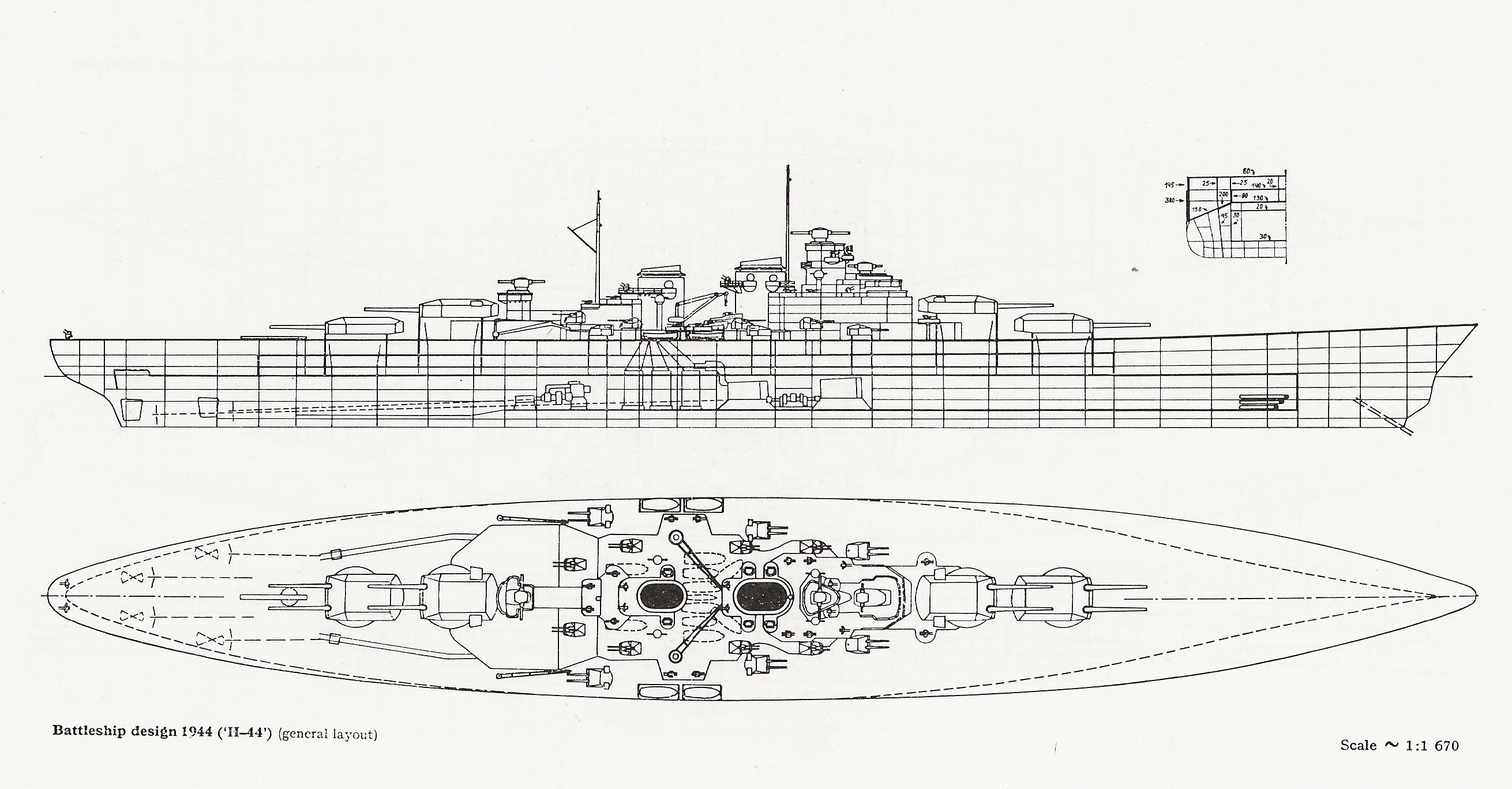
Breyer's drawing of H-44.
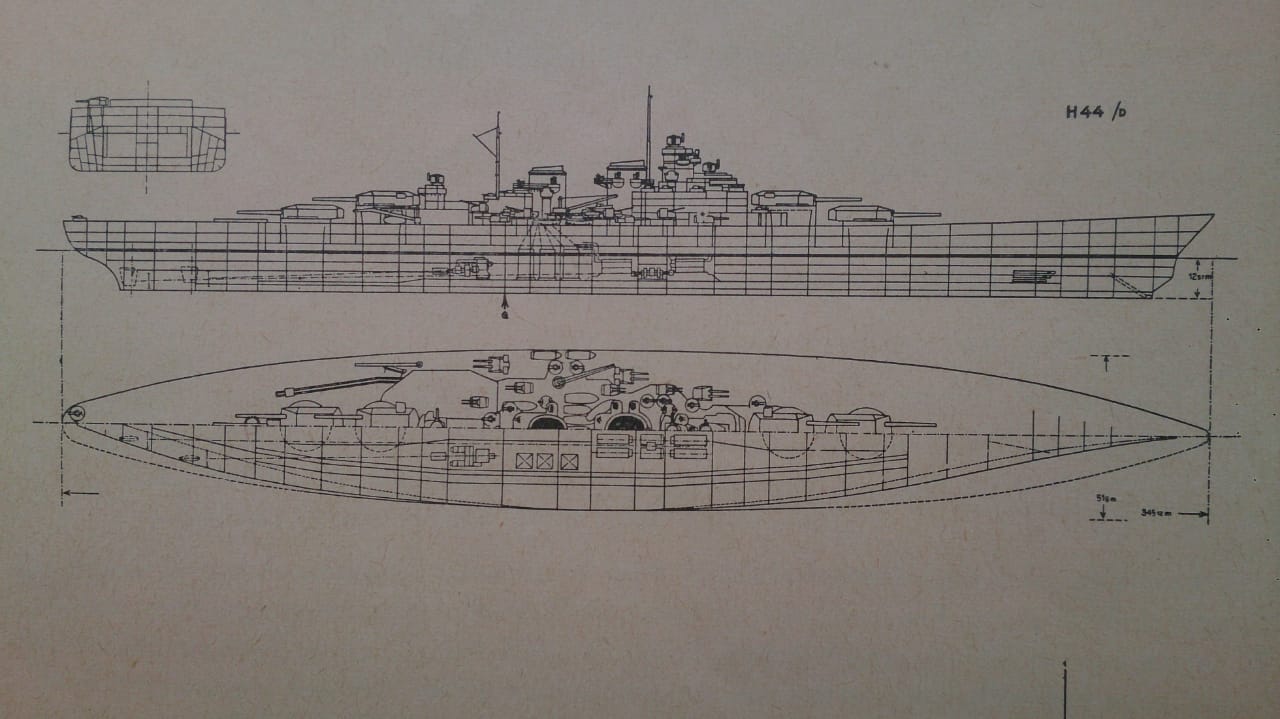
The anonymous drawing from Marine Rundschau, October 1956. Note that it is quite similar to Breyer's.
H-44, in besides being the largest battleship ever designed by a major power, (even if it was only a design study) had a different torpedo bulkhead system from her predecessors. While it was certainly larger, (11 meters on each side) there were two longitudinal armored bulkheads, 45mm and 30mm, extending from the keel to the main deck.
One of the first post-war references to H-44 was an anonymous article in the October 1956 issue of German journal "Marine Rundschau" This article was
given to us only recently, but it did not provide much information that was unfamiliar to us. The plan and profile drawing is remarkably similar to Breyer's later drawing, however
one might note that it indicates that the 345 meter length is an overall length. All other sources, including the cross-section in the same article, indicate that the 345 meter length
was measured at the waterline. The cross-section drawing, which is more detailed than any other we've seen, does introduce a mystery. The beam is listed as 44.3 meters, for a design
H-44 /M. The plan and profile drawing says design H-44 /D. This implies that there was more than one H-44 design. Obviously, more research is needed.
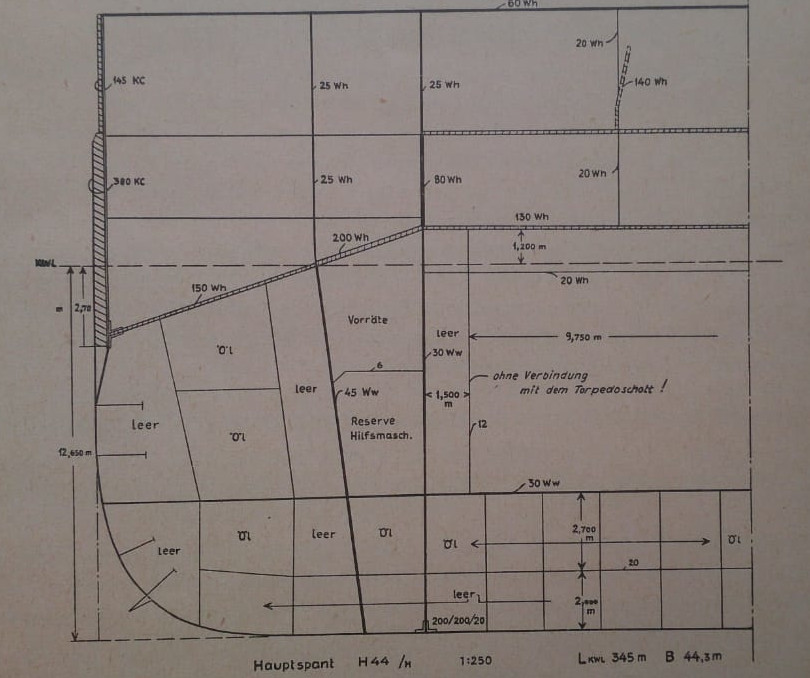 Cross sectional drawing from Marine Rundschau, October 1956. Note the cryptic H-44 /M designation, and the 44.3m beam.
Cross sectional drawing from Marine Rundschau, October 1956. Note the cryptic H-44 /M designation, and the 44.3m beam.
The (mostly) Fictional Designs from Wargaming
Let us state for the record that there is absolutely nothing wrong with making up purely fictional ship designs for wargames. We do it all the time. It can be fun. It only becomes a problem when people start to believe that these designs were real.
Since these are fictional designs, it is difficult to impossible to find good, reliable references on them. We are forced to rely on saved pictures and saved bits of text from
defunct websites, as well as personal memories.
So, here we present some more-or-less fictional designs that readers might find on the internet.
- The (mostly) Fictional H-45 Design

This may be the original H-45 sketch from "Seeadler's" posting on the Warships Projects Discussion Board.
Note how the style does not look like that of any official Kriegsmarine drawings
The H-45 design is almost entirely fiction. If H-40 through H-44 never made it off of the drawing board, H-45 never
even made it on to the drawing board! (at least not in the WW2 era) We probably wouldn't bother with this
legend at all if it hadn't proven so remarkably durable over the last couple of decades. It keeps popping up every
few years, and so it needs some formal "debunking".
Let's start with the little bit of truth at the core of this legend.
The German "Schwerer Gustav" railway guns were in fact real. They had a huge bore
of 80 cm, or about 31.5 inches, far bigger than any battleship gun. Two were built.
There is some dispute about whether or not Hitler suggested that such guns should be mounted on a battleship,
but regardless, no real design work was ever done on such a battleship.
Thus ends the "real" portion of the story.
We think that the story took on new life in the 1990s, when the Internet became more open to the general public. From what little evidence we can find, someone, possibly writing under
the pen name "Seeadler" read about Schwerer Gustav railway guns, and the dispute about whether Hitler thought they should be on battleships, and tried to design a battleship
to match the guns. He posted the drawing above. He may have been trying to demonstrate the absurdity of such a ship. There was some apparently some evidence of this on the defunct
Warships Projects Discussion Board, but all of that board's records seem to be long gone. I (DRW) remember being "trolled" with these statistics on a Usenet newsgroup in the
1990s, (remember Usenet???) but the troll vanished quickly when I pressed him for sources.
Below are some statistics that I recovered from a long-dead website around 2011. They do not seem to have changed much over the years.
| Statistics For the Imaginary Battleship H-45 "Führer"
|
|---|
| Displacement:(700,000 tons planned)
|
| light | 462,750 tons
|
| standard | 484,920 tons
|
| normal service | 560,057 tons
|
| full load | 617,927 tons
|
| Dimensions:
|
| Length: | 2,000 feet (609.60m)
|
| Beam: | 300 feet (91.44m)
|
| Draft: | 55 feet (16.75m)
|
| Armament:
|
| Main: | 8 31.5" (80cm) Gustav siege guns (4 x 2)
|
| Secondary: | 12 9.45"/73 (24cm) Long Range AA guns (12 x 1)
|
| Tertiary: | 24 5.04"/60 (12.8cm) AA guns (12 x 2)
|
| Light: | 5.5cm/77 Gerat 58, 30mm AA guns
|
| Broadside: | 131,574 lbs/59,631 kg
|
| Aircraft: | 15 aircraft
|
| Armor:
|
| Belt: | 14.96" (380mm) Deck: 14.96" (380mm)
|
| Turrets: | 25.96" (660mm) Conning tower: 24.8" (630mm)
|
| Machinery: | 8 shafts, (480,000 shp planned) 498,735 shp/372,057 kw
|
| Performance: | 28 knots; Range: 30,000 nm @ 20 knots
|
| Complement: | (5,000 planned) 10,236 13,307
|
| Distribution of weights:
|
| Armament: | 16,425 tons = 2.9%
|
| Armor: | 158,660 tons = 28.3%
|
| Machinery: | 11,931 tons = 2.1%
|
| Hull, fittings & equipment: | 274,955 tons = 49.1%
|
| Fuel, ammunition & stores: | 97,307 tons = 17.4%
|
| Miscellaneous weights: | 750 tons = 0.1%
|
An important clue suggesting that these statistics are not from WW2-era Germany is the use of "English" measurements. The length, beam and draft statistics are in even numbers of feet, and fractional numbers of meters. Since Germany switched to metric measurements long before WW2, we do not believe that these measurements were created in Germany. Since the United States is one of the last countries to use the old system, it seems most likely that the numbers were created by Americans. The numbers are consistent with the theory that they were created by wargamers in the 1990s.
The name on the design is also highly suspicious. Typically, German ships were not named until they were launched.
The 24cm Flak 85 (9.45"/73) heavy AA guns, 12.8cm/60 (presumably KM40), 5.5cm Gerat 58, and 3cm AA guns were all real, or at least were real projects. This however does not suggest that H-45 was real. Information about these guns is readily available. It wouldn't have been difficult for whoever created the fictional H-45 to find out about them. Campbell indicates that the 24cm Flak 85 was meant only for coastal batteries; 5.5cm Gerat 58 and the various 3cm guns were meant for destroyers and smaller ships. 12.8cm KM40 was an army gun adapted for naval use, though none were ever mounted in ships.
Some years later, a graphic artist known as "Leovictor" made a drawing of H-45. He is relatively well known for his pencil sketches of "never built" warships. To his credit,
on his own website, he does recognize that the story is little more than a fantasy. Anyhow, he made a number
of drawings based on the "Seeadler" drawing and the made-up statistics. These drawings have spread widely across the internet.
The drawing attributed to "Seeadler" has persisted as well. In 2019, someone using the name "Andrei Tapalaga" claimed
on this website, that it is an official plan, even though it is obviously not.
Much of this misinformation is also in
"Banelord300's" 2013 post on the European World of Warships forum, including the famed drawing.
Apparently, at least one published author fell for the H-45 hoax. David Porter's "World War II Data Book - Hitler's Secret Weapons 1933-1945" apparently included the H-45 data.
Someone using the name "Seeadler" on a long-dead board wrote:
"If he took information about H45 as describing a real ship I think he needs to read this site more closely or German naval technical design history more closely. I am the one who made H45 up. It was a ship of 700,000 tons (based on an engineer's estimates of a vessel capable of carrying 4 x 2 80xm guns). A heavy AA armament of 8 24 cm guns (the Kriegsmarine was developing such a gun for land base use at the end of the war) and numerous 12.8cm flak in enclosed mounts. I made a drawing of the ship and placed it on the site but I assure you it was entirely imaginary. If Mr. Porter merely googled the design without checking further then he did a disservice to his readers and to his reputation."
- The Großer Kurfürst Design from "World of Warships"
Like H-45 before it, this Großer Kurfürst Design comes from wargaming,
specifically from the popular internet game "World of Warships". While many
of the "Tier X" ships in this game were never built in reality, most of them
are at least based on real designs. From everything we've found so far, this one
is not.
Given the popularity of this game, we fear that this design, like H-45 before it,
might be mistaken for a real design.
| Statistics For the World of Warships Battleship "Großer Kurfürst"
|
|---|
| Displacement (standard??) | 70,800 tons
|
| Length: | 298 m
|
| Beam: | 38 m
|
| Main: | twelve 42 cm SK C/40 guns in four triple turrets
|
| Secondary: | eight 150mm/55 SK C/28
|
| Tertiary: | twenty 5.04"/61 (12.8cm) AA guns (10 x 2)
|
| Machinery: | 3 shafts, 220,000 SHP
|
| Performance: | 30 knots
|
Yes, we know that's not much to go on. It was all we could find on a quick search. We found it on this fan forum. Most of the other sites express the dimensions in game units.
These statistics leave us somewhat skeptical. The size of the ship is somewhere between that of H-41 and H-42, and yet she has 50% more main guns than either of those two designs. Krupp apparently did discuss a triple turret for the German 16" gun, (and of all people, Josef Stalin was interested in buying it!
)
but none was ever actually designed. Finally, we're not sure how they would have generated the power required on three shafts. Perhaps they would have used a combined diesel/steam turbine arrangement like that on Battlecruiser O, or the H-40A design.
In the end, we believe that this Großer Kurfürst design is simply an attempt at "play balance" for the "World of Warships" game. They wanted a ship that would be the German equivalent of a Montana, so they created one.
Thanks To......
The authors would like to thank friend who wishes to remain anonymous honoring the anonymous author of the Marine Rundschau 1956 publication
for his help obtaining and interpreting several rather obscure old articles.
Also, thanks to Michael Emmerich for advice and support.
Version History
| Version |
|
Date |
| Draft 0 | 0.0 | 16 July 2020 |
| Draft 1 | 0.1 | 21 July 2020 |
| Draft 2 | 0.2 | 15 October 2020 |
| Version 1 | 1.0 | 25 July 2021 |
Footnotes
Copyright ©2020 David R. Wells. All rights reserved.
Click Here
to return to the Wells Brothers' Battleships Index
Click Here to return
to the Wells Brothers' Home Page








